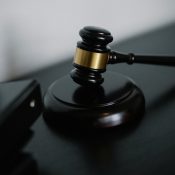Floor Coverings By-laws and Noise – Andelman v Small [2020] NSWCATAP 32
- Home
- Floor Coverings By-laws and Noise – Andelman v Small [2020] NSWCATAP 32

The prevalence of more employees working from their home instead of their workplaces during and after the coronavirus pandemic has certainly contributed to an increase in the level of noise being emitted within apartments in strata schemes.
The increase in noise levels obviously varies from apartment to apartment but may include noise caused by a resident walking or running on their hard floors being transmitted into another resident’s apartment.
In Andelman v Small [2020] NSWCATAP 32, the downstairs owner alleged that the owner directly above their unit was in breach of the owners corporation’s floor coverings by-law. The floor coverings by-law stated that each owner needed to ensure that all floor space within their lot other than in the kitchen, laundry, lavatory or bathroom, was covered or otherwise treated to an extent sufficient to prevent the transmission of noise from the floor space likely to disturb the peaceful enjoyment of the owner or occupier of another lot.
Although the downstairs owner had an acoustic engineer test the noise levels being transmitted, the acoustic engineer was unable to conduct their tests from within the upstairs owner’s lot as they refused him access.
The downstairs owner relied upon their acoustic expert’s report and evidence from a previous tenant attesting to the noise to prove the breach of the floor coverings by-law.
NCAT at first instance was satisfied and ordered the upstairs owner to ensure all floor space within their lot (with some exceptions) was covered or treated in accordance with the flooring by-law.
However, the upstairs owner subsequently appealed to the NCAT Appeal Panel against the NCAT decision arguing that only normal living noise emanated from the apartment that was home to her and her six year old. The upstairs owner also submitted that the noise needed to be excessive to be considered a contravention of the floor coverings by-law. The upstairs owner also argued that NCAT erred in failing to comprehend that any order should be based on objective evidence and that the test whether a by-law was being breached was objective, not subjective.
In dismissing the appeal, the NCAT Appeal Panel held, amongst other things, that:
- NCAT at first instance was right to reach the conclusion that it did base its finding on the acoustic expert’s evidence, the downstairs owner’s evidence and the former tenant’s evidence and the absence of any evidence being given by the upstairs owner.
- The test of whether the floor coverings by-law was breached was whether the noise being transmitted was “likely to disturb the peaceful enjoyment” of the lot beneath, not whether the noise was “normal living noise”, or “excessive”.
- On the evidence provided to NCAT at first instance and which NCAT accepted, there was noise being transmitted that was likely to disturb the peaceful enjoyment of the lower lot owner. Accordingly, the test posed by the floor coverings by-law was met.
- A fair reading of NCAT’s reasons indicates that NCAT didapply the objective test.
In light of the above decision, strata schemes may wish to consider reviewing their existing flooring by-laws and minor works by-laws to see if they adequately protect residents in relation to flooring works and associated noise transmission issues. If you need advice on your existing flooring or minor works by-laws or wish to amend them, we can help
Disclaimer: This is commentary published by Pobi Lawyers for general information purposes only and should not be relied upon as specific legal advice. You should obtain your own legal advice specific to your circumstances before you take any action or otherwise rely upon the contents of this article. The content of this article is subject to change.




